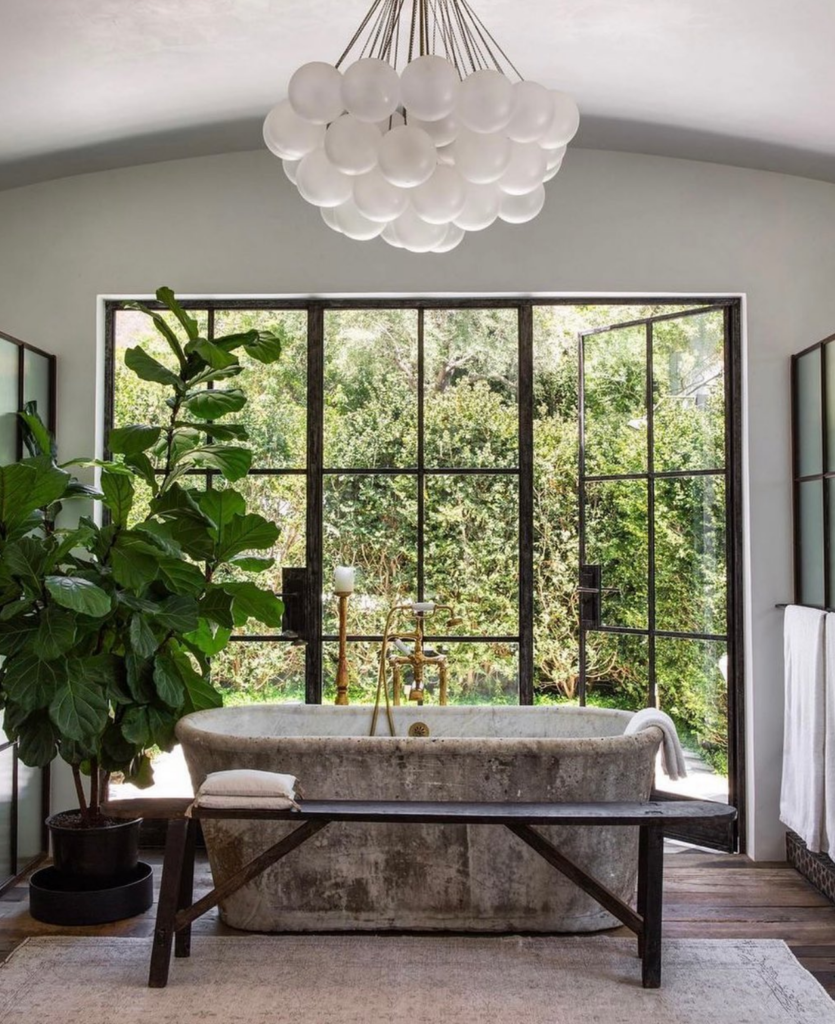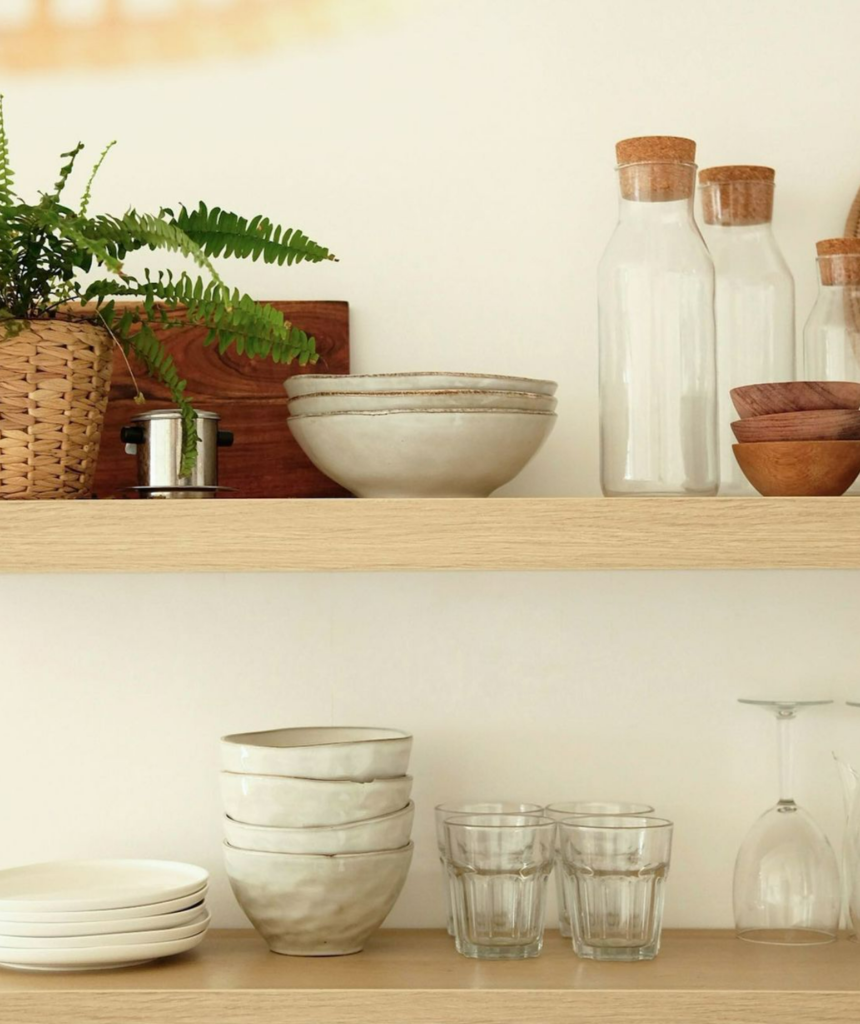If you’re striving to create a home where you can live simply and feel at your best, then the term ‘biophilia’ is one that you need to get familiar with.
The concept of biophilia, according to biologist E. O. Wilson, suggests that humans have an in-built need to connect ‘with nature and other forms of life’. Studies have shown that in doing so, the benefits are far reaching and include improving our mental health and well-being.

Connecting to nature has the ability to reduce stress, enhance our mood and creativity, and improve physical health. So by bringing the outside in and embracing biophilic design, we can help to support and enhance all of those benefits in the work place and in our own homes.
Biophilic design isn’t just about filling your home with indoor plants, although this is one way to meet the brief. There are many other ways that nature can inspire your design choices, so read on to find out how you can easily introduce biophilia into your home.
Open up to nature
The easiest way to embrace the concept of biophilia, is to literally open up your home to the nature you can see on your doorstep. Whether it’s a garden, a courtyard, a beach or a forest, embrace whatever you’re lucky enough to have outside your front door and try to allow the sights, sounds and smells of nature into your home at every opportunity.
Let in as much natural daylight as you possibly can, throw back the curtains and open the windows so you can feel the fresh air, hear the birds, and smell the freshly cut grass.
If you’re renovating or re-decorating, think of the environment outside as your picture, use windows to frame that picture, and consider the room layout to really make the most of that view, pointing furniture outwards rather than inwards.

You’re likely to find more peace and calm by facing your furniture at a beautiful garden setting than you are by turning your back on nature to look at a television. One classic design move is to position a work desk looking out over nature for that instant hit of stress-reducing calmness, and this approach can be taken to almost any room in the house.
Shapes
When you’re next in the garden or out on a nature walk, look around you and take note of the shape of everything you can see.
Without getting too scientific, while we may be able to see plenty of (what we perceive to be) straight lines – think honeycomb, spider webs, crystal edges, some tree trunks and palm leaves – you will notice that nature generally has a little more curve.
Softer or more rugged, imperfect and organic, everything in nature has this kind of design profile and it’s something we can look to to inspire our design choices.
A room filled with curves and soft edges, perhaps contrasting against some sharper lines to provide light and shade, just like in the natural world, is one way of introducing biophilia into the home.
In practical terms, this can be achieved through printed wallpaper, art work or prints and textures in soft furnishings. Biophilia shouldn’t be confused as being specific to just flowers, leaves and plants, so think outside of the box when it comes to shapes and find what hits the right note for you. A beautiful bubble pendant light, similar to the one above by Circa Lighting, can have real impact but is a subtler take on biophilia. Similar to the honeycomb cork wall tiles (below) from Portuguese Treasures, which are a perfect example of biophilic design in both shape and texture.
Texture and pattern
You can easily tap in to biophilia through the textures and patterns used to dress a space. A classic interior design trick is to layer up textures to give even the most neutral coloured rooms depth and interest. Mixing carefully considering natural textures can create that sense of harmony between the natural world and the comfort of our own home.
Think lambswool throws, layered jute and wool rugs alongside floral or leaf-printed patterns in wallpaper, artwork or cushions. Use natural wood in abundance through furnishings, accessories, flooring and wall panelling – a design trend which looks to be evolving and standing the test of time. Nature Wall are an example of a company who produce a more modern, Scandi-style take on wooden wall panelling which has Class A sound absorption, providing function as well as form.

There is undoubtedly a trend at the moment for natural textures in interior design. Jute, seagrass, cane, rattan and bamboo are all fibres which feature heavily on the pages on interior magazines and Instagram accounts where a natural vibe is achieved through lighting, soft furnishings and even seating. On a smaller scale, natural texture can be hugely effective when used in styling alongside even the most minimal and neutral items.
On a larger scale, wood isn’t your only option for textured walls and floors. Consider the use of stone for floors and furnishings, and the lovely warm tones and natural pattern in cork is perfect for wall coverings and accessories. There are of course a vast amount of wallpapers available which nail the biophilia brief. Florals, trees, animals… whatever your preference, try to keep the essence of biophilia by staying true to the natural colour palette and keeping those calm and creativity-inducing vibes in mind.
Supporting small businesses in their quest to create sustainable, nature-led materials is also a great move for unique and impactful interior design. Just imagine a feature wall in your home using this stunning pressed wallpaper by Organoid whose philosophy is ‘sustainability in every aspect’ and say that ‘the natural beauty of our surfaces comes from nature itself’. Inspiring, no?
The beauty of natural textures is that the overall look doesn’t have to feel like you’re recreating the outdoors. But look a little closer and you will see inspiration from the outside world in almost every corner, and feel the connection to nature and all the benefits that come with it without even realising.
Colour
To truly embrace the concept of biophilia and using it to enhance your wellbeing and mood, try playing up to those colour palettes which reflect the calmness of nature.
One classic palette is the blue and cream shades of the sea and sand. However the colour green is probably most representative of nature and is thought by colour theory experts to be a mood-boosting shade.

So whether you’re picking up the paint brush or bringing plant life indoors for that hit of green goodness, allow yourself to be inspired by the colour palettes in the outside world which brings you the most joy, zen and good vibes.
Indoor plants
Possibly the most obvious or well-known practice of biophilic interior design, is to welcome living plants into our homes. A clear method of bringing the outside in and connecting with nature, a house can be full to the brim with plant babies or simply have foliage strategically placed throughout the space in the areas which have most visibility or where the plants are simply able to thrive.
The colour and unstructured shapes of plant life provide that visual aesthetic which is so important to biophilic design, not to mention the natural benefits they can bring, including improving air quality and positive effects on mental health and well-being. Just be mindful of plants which may be toxic or harmful to children and pets.
Indoor trees are having a bit of a moment right now, and combined with pared back palettes, uncluttered spaces, earthy colours and soft lines and textures, it’s a recipe made in biophilia heaven.
If you’re feeling inspired or intrigued by biophilia, head over to our Biophilic Design Pinterest board for more beautiful interior inspiration.
Our ‘Inspired By…’ series aims to introduce our readers to people, concepts or designs which inspire us to lead a simply beautiful life. We hope you’ll join us each month to be inspired by something new.
Leave a Reply
Previous Post
Next Post
For more of our latest projects, follow along on instagram at @hyggeandcwtchstudio.
© hygge and cwtch creative studio 2023 | all rights reserved | privacy policy | cookie policy
considered Art & Design for Beautiful Spaces
cardiff, WALES




















[…] tone was spot on, and natural wood is always high up on our list of materials thanks to our love of biophillic design. Tonnes of character and a real homely […]
[…] are fundamentally driven and inspired by nature, and if colours harmonise in nature, they will harmonise in our home too. So rather than picking […]
[…] in any given position. Sightlines to nature through picture windows or wide open doors are key to biophilic design. Internally, the more we have visible within our sightline, the more open a space feels. If a […]
[…] and Cwtch Design Studio. Creating spaces which flow seamlessly between inside and outside, with biophilic-led design at the forefront, is what we do […]
[…] connection to nature is an innate human need and is brought to life within our homes through biophilic design. Blurring the lines between inside and outside – think plenty of plant life in our homes and […]